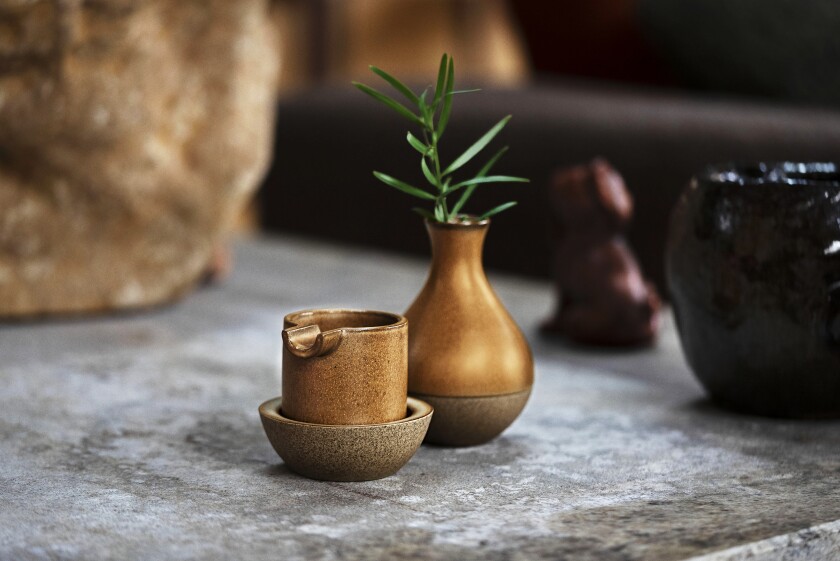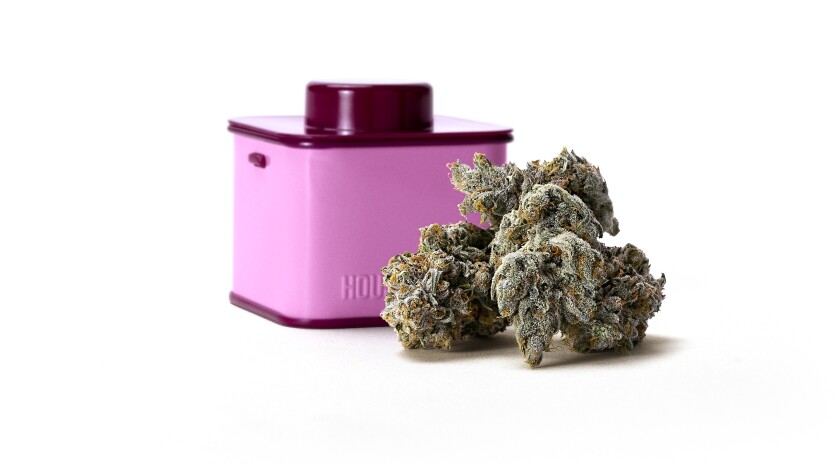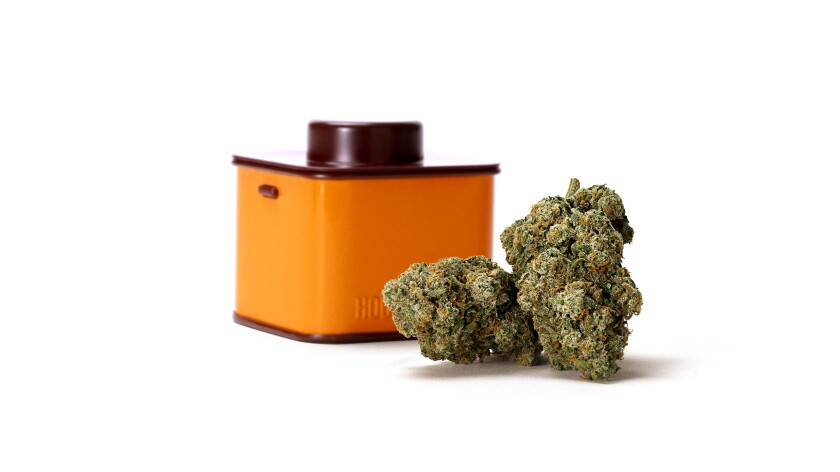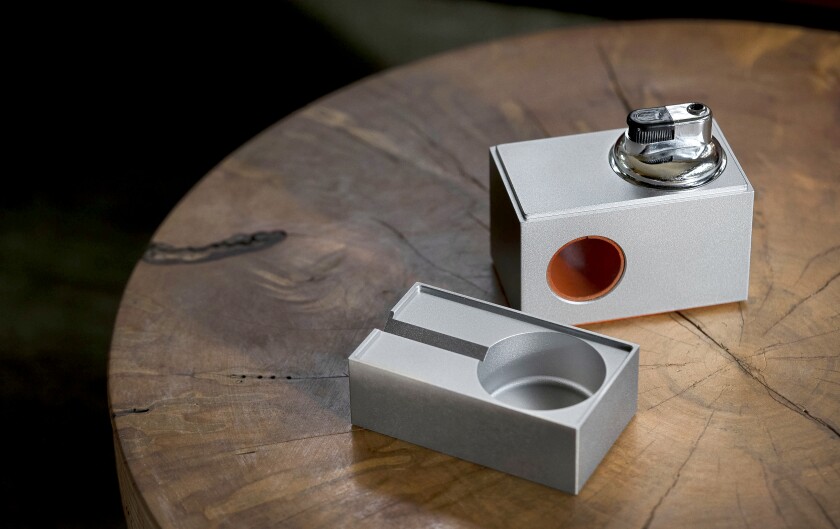Longtime friends Seth Rogen and Evan Goldberg, whose creative work together includes “Superbad,” “The Interview,” “This Is the End” and the weed-centric film “Pineapple Express,” turned their attention to a decidedly different form of entertainment with the 2019 launch of their cannabis brand Houseplant in Canada (both hail from Vancouver).
Two years later, Houseplant blooms on this side of the 49th parallel with three strains of cannabis flower named after weather systems: Diablo Wind, Pancake Ice and Pink Moon (a nod to “Pineapple Express,” which, long before it was a 2008 stoner comedy, referred both to a powerful, rain-packed “atmospheric river” and a powerful strain of cannabis). The strains are available via the Amuse delivery service in Los Angeles starting Thursday.
At the same time, they’re launching Houseplant’s first foray into home goods, which includes an $85 ashtray set designed by Rogen, a budding COVID-19 pandemic-era ceramist; a chunky $220 Mid-Century Modern-inspired table lighter; and a three-album vinyl box set ($95) of some of the dope-dabbling duo’s favorite music. (Unlike the cannabis, Houseplant’s Housegoods offerings are available for purchase online at houseplant.com.)

The three-piece ashtray set ($85) was designed by Rogen and features a bud vase, a bowl and a deep, mug-like ashtray with a notch to hold a joint. It’s one of the three items in the new Houseplant Housegoods brand extension.
(Houseplant)
In advance of Thursday’s launch, the 38-year-old Houseplant cofounders had a video chat with The Times (from their respective Los Angeles homes) about their lifelong passion for weed, what moviemaking and launching a cannabis brand have in common and what it’s like to get high hundreds of times in the name of research (a process Rogen described as “comically enjoyable”). Here are excerpts from that conversation.
You first launched the Houseplant cannabis brand in Canada two years ago. Are the strains you’re offering in the U.S. the same?
Evan Goldberg: No they’re completely different because it’s across the border.
Seth Rogen: The system is so different that the strains are completely different, [and] the regulations are very different. We’re working with California growers here in California, and all of our weed in Canada is grown in Canada.
Evan, Seth’s smoking is legendary. Do you smoke at the level he does?
Goldberg: [deadpans] I still haven’t tried the stuff. … We’re identical in our consumption, more or less. I tend to lean toward bongs and other things a bit more. Seth’s a joint man, but, beyond that, we share a desk, and pre-COVID, we’d share joints. I like the efficiency of the bong — clean and simple. I love a good joint too. I’m not anti-joint. … The bong is just largely because I work alone in a room a lot. But if I’m in a social setting, I much prefer the joint. I enjoy the social ritual.
Is there anything about creating a weed brand — and then a lifestyle brand to go with it — that’s similar to the way you guys collaborate on films?
Goldberg: One of the biggest things is just assembling the right team. It doesn’t matter how hard Seth and I work or how much thought we put into something, if we don’t have the right cinematographer and line producer and production designer, we’re not going to make a good movie. And it’s the same thing here. Without [Houseplant brand manager] Kaitlin [Juarez], [Houseplant Chief Executive and co-founder] Michael Mohr and [Chief Consumer Officer] Melissa Greenberg — the people we work with in our company — and having that team of incredibly talented people from different areas of expertise, we wouldn’t be able to pull off what we’ve done. [Houseplant’s other two founders are Alex McAtee and James Weaver, and Haneen Davies serves as chief commercial officer of L.A.-based Houseplant U.S.]
Rogen: Very much so. And I think, creatively, we’ve actually found that it’s a very similar pursuit in a lot of ways in that we’re trying to make a product that the audience loves and that they get a sense of who we are as people through that product, that we’re able to express ourselves through it, and people may relate to that themselves through that expression. That’s really what we’re trying do with our movies. And weirdly — in a way that I never could have imagined — I think we have found a way to instill our sensibilities into things like lighters and ashtrays, you know?
Goldberg: [I’d] add that a huge difference is that you release a movie at a moment in time, and it’s out and in the world. We don’t work on “Superbad” anymore, but this can evolve and be worked on for the rest of our lives. It’s an ever-changing thing, and that’s one of the most creatively thrilling things about it.

Pink Moon, a cross between the Tangie and Kosher Kush strains, has a THC content of 26.45% and is the only Houseplant indica strain at launch (suggested retail price is $60 for 3.5 grams, available via the Amuse delivery service). One of the brand’s thoughtful design elements is the color coding of tins: pink for indica strains, orange for sativas.
(Houseplant)
How did the selection process work to pick the three strains you’re launching with?
Goldberg: The important starting point is that we brought our life’s experience to it. We didn’t start at, “OK, let’s find good weed now.” We came to the table and really got scientific. We were like, “What do we love? What does it share with the other things we love?”
Rogen: Exactly. And “What are the strains we already love? The growers we already love and that we were already fans of?” We brought all that to the table as well. But, when it came time to really drill down on what strains we were proud to put in our little tin, it really had to be rigorously tested, and we would smoke ounces and ounces of the ones as we drilled down on to really make sure. [We asked ourselves,] “OK, can I smoke this all day every day?” and “Is this what I want?” I don’t want to lie to people or mislead people — ever. Can I honestly say this is the weed I want to be smoking? And it has to be. That’s the standard that it really had to hit for us.
So when you settled on the sativa strain Pancake Ice — the Chemdawg X Mandarin Cookies cross — did that mean there was a second runner-up strain that didn’t make the cut?
Goldberg: The second runner-up you’ll see in a couple months. We know that our personal tastes are not everybody’s taste, so we’re going to keep [adding] more strains to the mix.
Will you just be adding new strains or swapping some out like a limited-edition offering?
Rogen: I’m open to either. I personally hope we’ll always have Pancake Ice just so I can have access to it. It’s great, strong weed. Truthfully, Diablo Wind is more what me and Evan smoke all day long while we’re writing. It’s just slightly more functional. So those two strains are ones we really love, but we’re open. … That’s what’s fun about what Evan said about this being an ongoing creative endeavor. We can be really fluid with it in a way that we can’t always be with our films.

Pancake Ice, Rogen’s go-to strain, has a THC content of 33.32% and is packaged in an orange tin (sativa strains are in orange, indicas are in pink). It’s available in L.A. starting Thursday via the Amuse delivery service (suggested retail price $60 for 3.5 grams).
(Houseplant)
Seth, you’ve said your go-to strain is Pancake Ice. Do you have a preference, Evan?
Goldberg: Diablo Wind. [It’s] essentially an amalgam of two strains that Seth and I have been smoking for decades. We very much enjoy those specific strains.
Rogen: The Jack Herer [strain] that it’s derived from is one of our favorites strains, and we’ve been smoking it since we were teenagers. I think coming from Vancouver, especially, we were lucky in that we had access to some of these really pure kind of sativa strains that are hard to come by, and that smell of Jack [Herer] is always something that’s nostalgic for us almost.
Did you guys feel like kids in a candy shop when you were starting the strain-selection process?
Goldberg: I never liked candy this much. This is way better.
Rogen: It was comically enjoyable, and that was not lost on us. We are not smug or glib about it at all. The whole time we were like, “This is the ... greatest thing we could ever have been tasked with doing.”
How many times do you think you got high in service to picking the strains you’re launching with?
Rogen: We’d really try to live with them, honestly. Weed is a part of our day-to-day lives. It is an intrinsic part of my lifestyle, so we wanted to put the strains through that testing. So the answer is hundreds of times. We smoked ounces and ounces and ounces of each of these strains before we were really confident enough to put them to market. I was like, “I need to smoke this for weeks straight to make sure that it’s something that I really love.”
Why did you decide to name your strains after weather phenomena?
Rogen: We went with weather because we’re going to keep releasing strains — hopefully, we’ll have dozens of strains that we can put out into the world — and one of the reasons weather systems was a good area is because there’s tons of them with cool names. Pineapple Express is just sitting there. Ball lightning is one that I really like, [and] Venus’ Belts was one that caused a lot of controversy internally. St. Elmo’s fire ticks the movie box and the weather system box.
Talk about the inspiration behind the stackable tins the Houseplant cannabis is packaged in. They remind me of the kind of tins tea comes in.
Rogen: Tin is a highly recyclable material and it’s very light. That was very important to us, [and] we liked that it has a nostalgic feel to it. ... Truthfully, though, we wanted to make a tin that you were proud to display — not just one that didn’t look bad but one that actually looked nice and [that] you were happy to have out.
Goldberg: Every used one I have I use for something, which is the goal. I don’t throw any of them away.
Rogen: We have people asking to buy them in states where weed is not legal just so they can store things in them, which is very nice. But, honestly, that mentality is what really inspired a lot of the Housegoods. For so long, weed — and the things associated with it — were hidden and were not viewed as design objects or things that one should be proud to display. And that’s really what we wanted to make — things that if you’re someone who smokes weed or if you’re just someone who likes design that you’d be proud to have. And, as someone who smokes weed ... I found myself really struggling just to find a nice ashtray so I would buy vintage ashtrays because the ’60s and ’70s was the last time anyone was putting real design thought into these things. That’s really what started that conversation. What if we make our own versions of these things and kind of really tailor them to our lifestyles and what we would want and the functionality that we would be looking for. And it was very rewarding, and then I started doing ceramics and was actually able to physically design [some of] our products myself, which is not something I was expecting to be able to do, but it happened.

Houseplant’s Block Table Lighter ($220 at houseplant.com) has a Mid-Century Modern vibe and a lid that doubles as an ashtray. It was inspired by brand co-founder Seth Rogen’s uncanny ability to lose disposable lighters.
(Houseplant)
Is there a backstory to the chunky table lighter you’re offering? I imagine it has to do with someone losing a lot of lighters.
Goldberg: Seth’s wife and I talk about this constantly. Somewhere in Seth’s house — or life — is a portal filled with 15,000 to 25,000 lighters. It’s unfathomable. He buys trays of like 50 [lighters], and then a week later, we’ll be like, “Where’d all the lighters go?” And he’ll be like, “I don’t know.” It’s impossible. I can’t express how impossible it actually is. It must be a joke you’re playing that’s like 40 years long, and you’re going to [eventually] reveal a storage room [full of lighters].
Rogen: That would be a great joke. I remember 10 years ago, when I found out Evan and my wife were secretly texting one another about the fact that I lose a lot of lighters — and had been for a very long time. So, yeah, that was the motivation behind that.
If you time-traveled back a quarter century to when you two first got high together and told your younger selves that you’d eventually have your own line of cannabis and cannabis-inspired home goods, how do you think past you would respond to future you?
Rogen: I’d be so ... psyched, honestly. I’ve loved weed since I first started smoking it, and it’s something that I’ve put a lot of thought into for 25 years. And it’s thought that I [didn’t necessarily think] would lead to anything. It was just me thinking about a thing I really like. And the fact that now, in my late 30s, we found a way to take this thought and this energy and this passion and this love for this thing that we’ve had — me and Evan for 25 years — and that we’re finally able to manifest things with it is really exciting and really gratifying. And I would tell young me, “Yeah, anyone who tells you you should stop smoking weed, don’t listen to them.”
Houseplant cannabis is available for purchase in Los Angeles by those 21 and older starting Thursday via houseplant.amuse.com (suggested retail price for the three strains — Diablo Wind, Pancake Ice and Pink Moon — is $60 for 3.5 grams) with rollout to select bricks-and-mortar dispensaries slated for spring. For additional information and to order from the new home-goods collection, visit houseplant.com.
from Lifestyle https://ift.tt/2PQ8LjL
via IFTTT

comment 0 Comment
more_vert